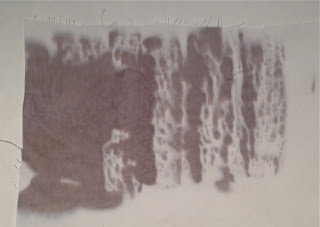Mono Printing on Fabric
Fabric used in the samples below was purchased as Ready to Dye (RTD) cotton homespun and poplin. The homespun was slightly heavier than the poplin however both took the dye and fabric paint very well.
For the samples I painted thickened dye mix and fabric paint onto perspex and glass sheets and created patterns with plastic card, card board, brush, brush handles and threads. Interesting and subtle effects were achieved which can be interpreted as markings from animals, birds and reptiles. I also used discharge paste over the dye to achieve a bleached effect.
Painting with Dye mix
I mixed dye powder with thickener to create a paste which could be applied to the surface and allow patterns to be drawn onto the surface. The perspex surface created unusual and natural effects using dye mix as the mix resisted some areas creating pockets of undyed fabric and a mottled effect. This resembled patterns and markings on reptiles and a second and third print from the same plate resulted in softer and more subtle effects.
The dye paint however resulted in a lighter shade than fabric which had been dyed using the immersion technique with the shibori methods. This provided variation in tone for use in later samples which I saw as an advantage rather than a problem.
Painting with Fabric Paint
I also applied acrylic fabric paint, Pebeo Setacolour, to obtain a darker and denser colour. This is applied, allowed to dry and heat set to create a permanent colour fast pattern. When dry the fabric is slightly stiffer than dye however it did result in sharper patterns. I created a series of prints with a second and third application of fabric to produce lighter and softer patterns.
A thread of fabric was accidentally laid across the glass in one sample and the effect spurred me on to create some samples using thread either as a resist to the dye or painted to create interest and diversity in patterns.
Discharge Paste
I experimented with discharge paste produced solely for use with cold water fibre reactive dyes. I did try bleaching the colour however this was not as effective on the dyed fabric. Samples below show the discharge paste painted on gathered fabric, stencilled and applied to glass for mono printing. Again this technique provides a subtle gradation from the finished dye colour to underlying colours and lends itself to interpretation for animal markings.
The black/green based dye bleached back to a yellow/brown while the jet black dye bleached back to a dark purple/brown yielding a very pleasant result.
Some samples had been previously dyed using the 'tritik' shibori technique. I dyed these using the immersion technique and the dye penetrated all the fabric which was somewhat disappointing but a good learning experience. An interesting side effect however is that on these pieces the original stitching provided somewhat of a resist and has created a subtle pattern of lines across these fabrics.
 |
| Bleach applied to dyed fabric which was then mono printed with dye painted on glass plate |



















3 comments:
Can i use this method for printing on plastic?
Printing on Plastic
Beautiful and informative post, I like it, i will use it in my business Plastic card Printing .
Thanks for your comments. I created patterns on plastic, perspex and glass to then overlay fabric to create mono prints with the dye and fabric paint. The same technique can be used to print on any surface as long as the medium used is suitable for that surface. Happy printing! Sabina
Post a Comment